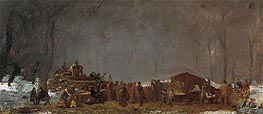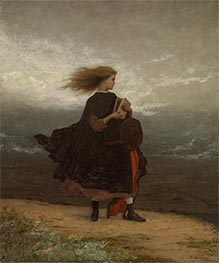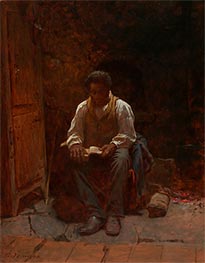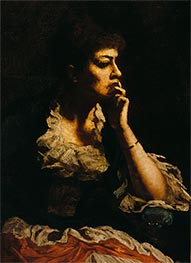
Eastman Johnson Painting Reproductions 1 of 1
1824-1906
American Realist Painter
Jonathan Eastman Johnson (July 29, 1824 - April 5, 1906) was an American painter. He was best known for his genre paintings, paintings of scenes from everyday life, his portraits both of everyday people, but he also painted portraits of prominent Americans such as Abraham Lincoln, Nathaniel Hawthorne, Ralph Waldo Emerson, and Henry Wadsworth Longfellow. His later works often show the influence of the 17th century Dutch masters whom he studied while living in The Hague and he was even known as The American Rembrandt in his day.
Johnson was born in Lovell, Maine, the eighth and last child of Philip Carrigan Johnson and Mary Kimball Chandler. His eldest brother Rear Admiral Philip Carrigan Johnson Jr. (father of Vice Admiral Alfred Wilkinson Johnson) was followed by his beloved sisters Harriet, Judith, Mary, Sarah, Nell and his brother Reuben. Eastman grew up in Fryeburg and Augusta.
His career as an artist began in 1840 when his father, and innkeeper, apprenticed him to a Boston lithographer. In 1849 he moved to Dusseldorf, Germany where many artists, including many Americans, studied Art and there was accepted into the studio Emanuel Gottlieb Leutze, a German who had lived in the United States for a while before returning to Germany. Johnson then moved to The Hague and studied 17th century Dutch and Flemish masters. He ended his European travels in Paris, studying with the academic painter Thomas Couture in 1855. After returning to America in 1855 due to the death of his mother. In 1857 he lived and painted among the native Anishinaabe (Ojibwe) near Superior, Wisconsin. In 1859, he established a studio in New York city and secured his reputation as an American artist with an exhibition featuring his painting Negro Life at the South or as it is more popularly known Old Kentucky Home.
He was also a member of the Union League Club of New York, which holds many of his paintings.
Style
Johnson's style is largely realistic in both subject matter and in execution. His original photorealistic charcoal sketches were not strongly influenced by period artists, but are informed more by his lithography training. Later works show influence by the 17th century Dutch and Flemish masters, and also by Jean Francois Millet. Echoes of Millet's The Gleaners can be seen in Johnson's The Cranberry Harvest, Island of Nantucket although the emotional tone of the work is far different.
His careful portrayal of individuals rather than stereotypes enhances the realism of his paintings. Ojibwe artist Carl Gawboy notes that the faces in the 1857 portraits of Ojibwe people by Johnson are recognizable in people in the Ojibwe community today. Some of his paintings such as Ojibwe Wigwam at Grand Portage display near photorealism long before the photorealism movement but in keeping with the American tradition of realism that can be seen in the works of Charles Willson Peale whose painting The Stairway Group is said to have fooled George Washington.
His careful attention to light sources contributes to the realism. Portraits Girl and Pets and The Boy Lincoln make use of single light sources in a manner that echoes the 17th Century Dutch Masters.
Subject matter
Jonhson's subject matter included portraits of the wealthy and influential from the President of the United States, to literary figures to portraits of unnamed individuals, but he is best know for his genre work, his paintings of everyday people in everyday scenes. Johnson often repainted the same subject changing style or details.
New England
His depictions of New England life, such as ''The Cranberry Harvest, Island of Nantucket, The Old Stagecoach, Husking Bee, Island of Nantucket, The Sap Gatherers, and Sugaring Off at the Camp, Fryeburg, Maine established him solidly as a genre painter. Over the course of five years, he made many sketches and smaller paintings depicting the process of turning maple sap into maple sugar, but never completed the larger work he had started.
In contrast, the much celebrated Old Stagecoach was mostly staged in his studio and its composition carefully planned. The stage coach itself originated as an abandoned coach that he encountered and sketched while hiking in the Catskils. The children were painted from local children recruited from near his Nantucket Studio. Despite this artifice, the painting was celebrated as wholesome, natural and bucolic.
After his return from Europe, Johnson went to visit his sister in what was then the western frontier of Wisconsin. Carl Gawboy, a modern day Ojibwe artist, has posited that Johnson's guide was likely George Bonga, a son of Pierre Bonga, a freed slave, who had married an Ojibwe woman. Gawboy speculates that Johnson's time with this mixed-race family changed his approach to painting. Certainly Johnson was successful in getting many Ojibwe to sit for him. His drawings and painting depict Ojibwe people in a much more intimate and relaxed manner than is usual for painting of that period. Also unusual was that he often included the subject's names in the title of the works. He did not focus solely on individual portraits, but also did paintings and sketches of scenes which including the Ojibwe dwellings, St. Louis bay, and other groupings of Ojibwe in everyday activities.
Johnson left Wisconsin due to wide spread financial panic that rendered his real estate investments there worthless. He left there for Cincinnati, Ohio to make money via portrait commissions and did not return to the subject of the Ojibwe. His paintings and sketches of the Ojibwe remained unsold during his lifetime and now are in the possession of the Tweed Museum of Art on the campus of University of Minnesota Duluth.
Slavery
Negro Life at the South is considered Johnson's masterpiece. Although this painting was popularly known as Old Kentucky Home nearly from the beginning, it depicts a scene from Washington, D.C.
The painting is a domestic scene behind a dilapidated house. On the right in the foreground is a couple courting, in the middle there is a banjo player playing while an adult woman dances with a child as others look on. One of the onlookers, far to the right is a young white woman in an elegant white dress. Above the scene, an adult woman looks out a window as she steadies a small child sitting on the partially collapsed roof. Skin tones vary in the scene from person to person. Aside from the white observer on the far right, the palest person in the scene is the young woman being courted. The darkest skin belongs to the woman dancing with the child in the middle foreground. Some have viewed this as simple realism, others see it as an invitation to the viewer to contemplate the mixed racial heritage of those portrayed. Both proponents and detractors of slavery have seen this painting as defending their positions.
Another painting of Johnson's is less open to interpretation. A Ride for Liberty - The Fugitive Slaves painted in 1862, depicts a slave family riding to freedom. This painting is based on Johnson's observations during the Civil War battle of Manassas.
Johnson was born in Lovell, Maine, the eighth and last child of Philip Carrigan Johnson and Mary Kimball Chandler. His eldest brother Rear Admiral Philip Carrigan Johnson Jr. (father of Vice Admiral Alfred Wilkinson Johnson) was followed by his beloved sisters Harriet, Judith, Mary, Sarah, Nell and his brother Reuben. Eastman grew up in Fryeburg and Augusta.
His career as an artist began in 1840 when his father, and innkeeper, apprenticed him to a Boston lithographer. In 1849 he moved to Dusseldorf, Germany where many artists, including many Americans, studied Art and there was accepted into the studio Emanuel Gottlieb Leutze, a German who had lived in the United States for a while before returning to Germany. Johnson then moved to The Hague and studied 17th century Dutch and Flemish masters. He ended his European travels in Paris, studying with the academic painter Thomas Couture in 1855. After returning to America in 1855 due to the death of his mother. In 1857 he lived and painted among the native Anishinaabe (Ojibwe) near Superior, Wisconsin. In 1859, he established a studio in New York city and secured his reputation as an American artist with an exhibition featuring his painting Negro Life at the South or as it is more popularly known Old Kentucky Home.
He was also a member of the Union League Club of New York, which holds many of his paintings.
Style
Johnson's style is largely realistic in both subject matter and in execution. His original photorealistic charcoal sketches were not strongly influenced by period artists, but are informed more by his lithography training. Later works show influence by the 17th century Dutch and Flemish masters, and also by Jean Francois Millet. Echoes of Millet's The Gleaners can be seen in Johnson's The Cranberry Harvest, Island of Nantucket although the emotional tone of the work is far different.
His careful portrayal of individuals rather than stereotypes enhances the realism of his paintings. Ojibwe artist Carl Gawboy notes that the faces in the 1857 portraits of Ojibwe people by Johnson are recognizable in people in the Ojibwe community today. Some of his paintings such as Ojibwe Wigwam at Grand Portage display near photorealism long before the photorealism movement but in keeping with the American tradition of realism that can be seen in the works of Charles Willson Peale whose painting The Stairway Group is said to have fooled George Washington.
His careful attention to light sources contributes to the realism. Portraits Girl and Pets and The Boy Lincoln make use of single light sources in a manner that echoes the 17th Century Dutch Masters.
Subject matter
Jonhson's subject matter included portraits of the wealthy and influential from the President of the United States, to literary figures to portraits of unnamed individuals, but he is best know for his genre work, his paintings of everyday people in everyday scenes. Johnson often repainted the same subject changing style or details.
New England
His depictions of New England life, such as ''The Cranberry Harvest, Island of Nantucket, The Old Stagecoach, Husking Bee, Island of Nantucket, The Sap Gatherers, and Sugaring Off at the Camp, Fryeburg, Maine established him solidly as a genre painter. Over the course of five years, he made many sketches and smaller paintings depicting the process of turning maple sap into maple sugar, but never completed the larger work he had started.
In contrast, the much celebrated Old Stagecoach was mostly staged in his studio and its composition carefully planned. The stage coach itself originated as an abandoned coach that he encountered and sketched while hiking in the Catskils. The children were painted from local children recruited from near his Nantucket Studio. Despite this artifice, the painting was celebrated as wholesome, natural and bucolic.
After his return from Europe, Johnson went to visit his sister in what was then the western frontier of Wisconsin. Carl Gawboy, a modern day Ojibwe artist, has posited that Johnson's guide was likely George Bonga, a son of Pierre Bonga, a freed slave, who had married an Ojibwe woman. Gawboy speculates that Johnson's time with this mixed-race family changed his approach to painting. Certainly Johnson was successful in getting many Ojibwe to sit for him. His drawings and painting depict Ojibwe people in a much more intimate and relaxed manner than is usual for painting of that period. Also unusual was that he often included the subject's names in the title of the works. He did not focus solely on individual portraits, but also did paintings and sketches of scenes which including the Ojibwe dwellings, St. Louis bay, and other groupings of Ojibwe in everyday activities.
Johnson left Wisconsin due to wide spread financial panic that rendered his real estate investments there worthless. He left there for Cincinnati, Ohio to make money via portrait commissions and did not return to the subject of the Ojibwe. His paintings and sketches of the Ojibwe remained unsold during his lifetime and now are in the possession of the Tweed Museum of Art on the campus of University of Minnesota Duluth.
Slavery
Negro Life at the South is considered Johnson's masterpiece. Although this painting was popularly known as Old Kentucky Home nearly from the beginning, it depicts a scene from Washington, D.C.
The painting is a domestic scene behind a dilapidated house. On the right in the foreground is a couple courting, in the middle there is a banjo player playing while an adult woman dances with a child as others look on. One of the onlookers, far to the right is a young white woman in an elegant white dress. Above the scene, an adult woman looks out a window as she steadies a small child sitting on the partially collapsed roof. Skin tones vary in the scene from person to person. Aside from the white observer on the far right, the palest person in the scene is the young woman being courted. The darkest skin belongs to the woman dancing with the child in the middle foreground. Some have viewed this as simple realism, others see it as an invitation to the viewer to contemplate the mixed racial heritage of those portrayed. Both proponents and detractors of slavery have seen this painting as defending their positions.
Another painting of Johnson's is less open to interpretation. A Ride for Liberty - The Fugitive Slaves painted in 1862, depicts a slave family riding to freedom. This painting is based on Johnson's observations during the Civil War battle of Manassas.
4 Eastman Johnson Paintings

The Maple Sugar Camp - Turning Off c.1865/73
Oil Painting
$950
$950
Canvas Print
$50.59
$50.59
SKU: JEJ-5697
Eastman Johnson
Original Size: 25.7 x 57.4 cm
Thyssen-Bornemisza Museum, Madrid, Spain
Eastman Johnson
Original Size: 25.7 x 57.4 cm
Thyssen-Bornemisza Museum, Madrid, Spain

The Girl I Left Behind Me c.1872
Oil Painting
$1077
$1077
Canvas Print
$63.72
$63.72
SKU: JEJ-18203
Eastman Johnson
Original Size: 106.7 x 88.7 cm
Smithsonian American Art Museum, Washington, USA
Eastman Johnson
Original Size: 106.7 x 88.7 cm
Smithsonian American Art Museum, Washington, USA

The Lord Is My Shepherd 1863
Oil Painting
$726
$726
Canvas Print
$50.59
$50.59
SKU: JEJ-18204
Eastman Johnson
Original Size: 42.3 x 33.2 cm
Smithsonian American Art Museum, Washington, USA
Eastman Johnson
Original Size: 42.3 x 33.2 cm
Smithsonian American Art Museum, Washington, USA

Portrait of Mrs. Eastman Johnson c.1888
Oil Painting
$947
$947
Canvas Print
$55.48
$55.48
SKU: JEJ-18205
Eastman Johnson
Original Size: 79.7 x 58 cm
Smithsonian American Art Museum, Washington, USA
Eastman Johnson
Original Size: 79.7 x 58 cm
Smithsonian American Art Museum, Washington, USA